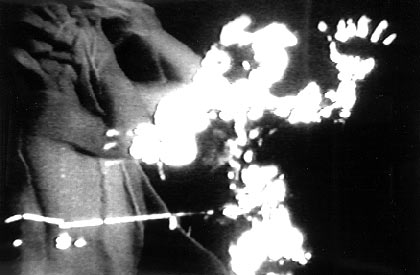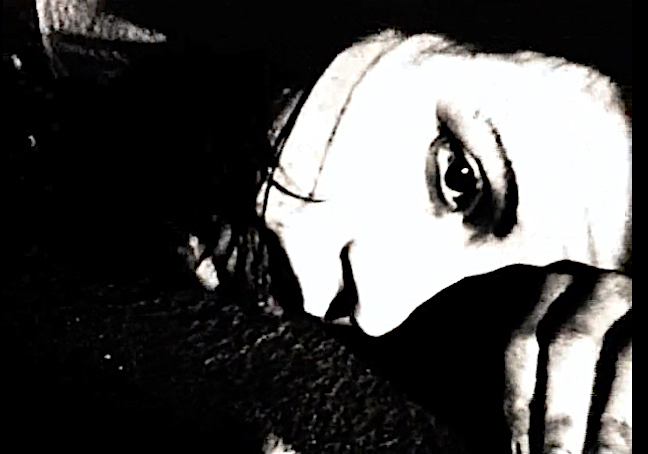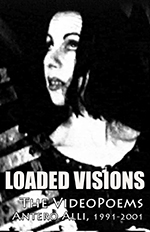


Film Review by David Finkelstein
for filmthreat.com 4 stars out of 5 (7/13/2010)
LOADED VISIONS (1991-2001; 73 min. USA)
This superior collection of short films made over the course of a decade shows that Antero Alli, who has made many feature length films, is also a master of the short form. Set to poetic texts, often to excellent music by his long time collaborator Sylvi Alli, these films show Alli’s command of film editing and visual language, and his ability to draw performances of deeply grounded power from dancers and actors, to create visions which are indeed “loaded.” They are loaded with the ability to evoke deep longings, exaltations, historic and cultural memories, and altered spiritual states. Here are some highlights:
In “Fairy” (2001) we hear Rimbaud’s prose poem of the same name (from “Illuminations”) intoned beautifully and softly in English by Sylvi Alli, while it is also whispered in French by Michelle Marie. Rimbaud’s almost abstract prose poem creates a powerful impression through sound and the kinetic force of the images, which indistinctly refer to a girl and her enchanted relation with a “dead love.” Two dancers, Deanna Anderson and Nick Walker, perform an abstract accompaniment to the poem, in which Walker, a fanged and horned spirit covered with leaves, reaches up from the ground and entangles himself with Anderson in an erotically-tinged duet. The subtle, yet deeply rooted performances of the dancers and the narrators make this simple film gripping and evocative. A companion piece, “Mouvement,” is a setting of a different Rimbaud text, and it is completely different and also highly effective.
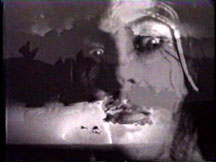

DEANNA ANDERSON in "Moouvement" and KATHERINE RICE in "Book of Questions"
In the haunting short “The Book of Questions,” (1993), an older man lies sick in bed, being cared for by his grown daughter. In dream sequences, we see the man with the daughter, now a child, in a variety of strange and surreal vignettes, while listening to Pablo Neruda’s whimsical poem. Sylvi’s music here is especially lovely.
Sean Blosl’s text and his electronic and percussion score form the soundtrack for the disorienting and creepy “Some Pass This Way” (1994). Filmed in abandoned bunkers, the setting is made creepier by having the black interior lit only by swinging, flickering flashlights. Dancers Jyl Brewer and Ed Byrne portray the inhabitants of what might be their own personal hells. They look at times like victims of torture, thrown into a dungeon, or celebrants of a Black Mass, lighting candles. The dancers thrash on several levels of netting hung in the space.
In “D.U.I.” (Driving under the influence) (1991),we hear Alli’s voice-over text about a man trying to stay focused while driving extremely drunk. The complex and beautifully made montage of images represents things he sees on the road and in his mind as he weaves in and out of clarity. He switches on the radio, and we hear a call-in show, discussing Wilhelm Reich’s philosophy of the function of nightmare. (It’s to wake us up.) His vision culminates in a glimpse of a room full of crystals. Perhaps his drinking was an inchoate attempt to reach out towards clarity.
“Witch Burning” (1998) skillfully illustrates Sylvia Plath’s poem with a performance by dancer Ed Byrne, collaged wonderfully with a variety of images of flames, burning effigies, and cracked earth. The film, avoiding all literal depiction, expertly uses abstraction to recall the history of the burnings of heretics and dissidents of many kinds.
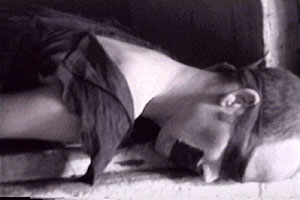
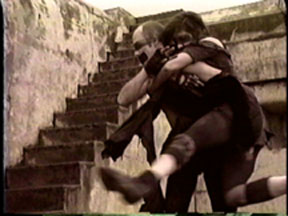
ED BYRNE and JYL BREWER in "COLD FORCE"
“Cold Force” (1994) is set to Alli’s poetic text about an alien force which moves through him, frightening a woman. A concrete courtyard and staircase, stills of ancient sites, a desertscape with reptiles, and a powerfully muscular dance duet by Jyl Brewer and Ed Byrne are elements which make up this absorbingly abstract drama.
At 27 minutes, “Lily in Limbo” (2001) is the longest work. A (small) epic poem about a woman’s spiritual quest, the film is a collaboration between Sylvi and Antero Alli. Sylvi performs in the film as well, and it also features her music on the soundtrack. The film is set to excerpts from H.D.’s visionary poem “Trilogy.” A woman wavers back and forth between her waking life and a complex dream she is trying to recall. The dream footage, shot mostly on grainy, pulsating film, contrasts nicely with the crisp black and white video imagery of her waking life, alone in her apartment. In the haunting dream images, she wanders through an abandoned building, down a lone pier, and gazes into a mirror at an altar. The images poetically address her quest to break out of her overly brittle, confining concept of who she is. It is her birthday, and gorgeous images of water symbolize her rebirth. (She’s a Pisces.) An uncanny event near the film’s end connects her waking life to her dream. The film ends with a stunning, poetic sequence, which depicts something I would have thought impossible to capture on film: the sensation when one lets go of preconceptions, and one is flooded with a feeling of spiritual enlightenment. This is depicted, quite accurately, through the images of flowers opening, superimposed over images of a lava flow, in which the elements of earth, fire, air and water are all intermingled.
